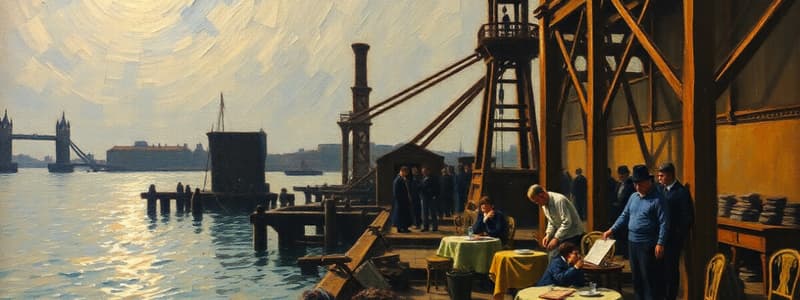Podcast
Questions and Answers
What is the total fixed cost (TFC) when the output is 3 units?
What is the total fixed cost (TFC) when the output is 3 units?
- 80 (correct)
- 200
- 120
- 26.67
What is the marginal cost (MC) of producing the 4th unit of output?
What is the marginal cost (MC) of producing the 4th unit of output?
- 50
- 70 (correct)
- 40
- 100
Which of the following statements is true about the relationship between average variable cost (AVC) and marginal cost (MC)?
Which of the following statements is true about the relationship between average variable cost (AVC) and marginal cost (MC)?
- AVC always increases when MC increases.
- AVC and MC are always equal.
- AVC and MC intersect at the minimum point of AVC (correct)
- AVC always decreases when MC decreases.
What is the main difference between short-run and long-run cost curves?
What is the main difference between short-run and long-run cost curves?
Why is the long-run cost curve called an 'envelope' curve?
Why is the long-run cost curve called an 'envelope' curve?
What occurs when the Marginal Cost (MC) curve starts rising?
What occurs when the Marginal Cost (MC) curve starts rising?
Why is the Long Average Cost (LAC) curve referred to as an Envelop curve?
Why is the Long Average Cost (LAC) curve referred to as an Envelop curve?
What does the learning curve depict regarding production costs?
What does the learning curve depict regarding production costs?
In the context of the provided data, what is the Average Fixed Cost (AFC) when output is 3?
In the context of the provided data, what is the Average Fixed Cost (AFC) when output is 3?
How does increased experience affect a firm's cost structure?
How does increased experience affect a firm's cost structure?
What is defined as the cost directly incurred by an individual or firm in producing a good or service?
What is defined as the cost directly incurred by an individual or firm in producing a good or service?
Which of the following represents the total expenditure on all fixed and variable factors for producing a commodity?
Which of the following represents the total expenditure on all fixed and variable factors for producing a commodity?
If a firm has zero output, which type of cost is also zero?
If a firm has zero output, which type of cost is also zero?
What does the average cost (AC) of production represent?
What does the average cost (AC) of production represent?
What would be the correct formula for marginal cost (MC)?
What would be the correct formula for marginal cost (MC)?
Which type of cost is incurred by society as a result of the production of a commodity?
Which type of cost is incurred by society as a result of the production of a commodity?
What is the main purpose of understanding costs for managerial decision-making?
What is the main purpose of understanding costs for managerial decision-making?
The cost that represents the amount to replace an existing asset is known as what?
The cost that represents the amount to replace an existing asset is known as what?
What defines marginal cost (MC)?
What defines marginal cost (MC)?
Which of the following correctly distinguishes between sunk cost and incremental cost?
Which of the following correctly distinguishes between sunk cost and incremental cost?
How is implicit cost defined?
How is implicit cost defined?
What distinguishes accounting costs from economic costs?
What distinguishes accounting costs from economic costs?
In the short run, how does total fixed cost (TFC) behave as output increases?
In the short run, how does total fixed cost (TFC) behave as output increases?
What is the relationship between total variable cost (TVC) and output level?
What is the relationship between total variable cost (TVC) and output level?
Which statement best describes the shape of the total fixed cost (TFC) curve?
Which statement best describes the shape of the total fixed cost (TFC) curve?
At zero output, what is the value of total variable cost (TVC)?
At zero output, what is the value of total variable cost (TVC)?
Which of the following statements is TRUE about the relationship between total cost (TC) and total variable cost (TVC)?
Which of the following statements is TRUE about the relationship between total cost (TC) and total variable cost (TVC)?
Flashcards
Short-run cost curve
Short-run cost curve
Represents costs where fixed costs remain constant.
Long-run cost curve
Long-run cost curve
Represents costs with both fixed and variable costs changing.
Fixed costs
Fixed costs
Costs that do not change with the level of production.
Variable costs
Variable costs
Signup and view all the flashcards
Average Cost (AC)
Average Cost (AC)
Signup and view all the flashcards
Marginal Cost (MC)
Marginal Cost (MC)
Signup and view all the flashcards
Sunk Cost
Sunk Cost
Signup and view all the flashcards
Incremental Cost
Incremental Cost
Signup and view all the flashcards
Implicit Cost
Implicit Cost
Signup and view all the flashcards
Explicit Cost
Explicit Cost
Signup and view all the flashcards
Accounting Cost
Accounting Cost
Signup and view all the flashcards
Economic Cost
Economic Cost
Signup and view all the flashcards
Total Fixed Cost (TFC)
Total Fixed Cost (TFC)
Signup and view all the flashcards
MC Curve and AVC Intersection
MC Curve and AVC Intersection
Signup and view all the flashcards
AC and MC Relationship
AC and MC Relationship
Signup and view all the flashcards
Long Run Average Cost (LAC) Curve
Long Run Average Cost (LAC) Curve
Signup and view all the flashcards
Learning Curve Effect
Learning Curve Effect
Signup and view all the flashcards
Experience Curve
Experience Curve
Signup and view all the flashcards
Private Cost
Private Cost
Signup and view all the flashcards
Social Cost
Social Cost
Signup and view all the flashcards
Historical Cost
Historical Cost
Signup and view all the flashcards
Replacement Cost
Replacement Cost
Signup and view all the flashcards
Total Cost (TC)
Total Cost (TC)
Signup and view all the flashcards
TVC Curve
TVC Curve
Signup and view all the flashcards
Total Cost (TC) Curve
Total Cost (TC) Curve
Signup and view all the flashcards
Cost Function
Cost Function
Signup and view all the flashcards
AFC
AFC
Signup and view all the flashcards
AVC
AVC
Signup and view all the flashcards
AC
AC
Signup and view all the flashcards
MC
MC
Signup and view all the flashcards
Relationship between AC, AVC, AFC, and MC
Relationship between AC, AVC, AFC, and MC
Signup and view all the flashcards
Study Notes
Chapter 7 - Cost Concepts
- Cost concepts cover the relationship between costs and output in short-run and long-run scenarios.
- Short-run and long-run cost curves, and numerical problems are central to understanding cost.
- Long-run average cost analysis is essential, along with learning curves.
Concepts of Cost
- Firms maximize profit by focusing on revenues and costs.
- Profit can be increased by either increasing revenue or reducing cost.
- Market forces generally dictate revenue, while cost reduction can be influenced by factors like production efficiency and output optimization.
- Cost analysis helps businesses decide prices and production decisions.
Private and Social Cost
- Private cost are incurred directly by the producer or firm for the good or service.
- Social cost is incurred by the society due to commodity production, often beyond the producer's direct costs.
Historical and Replacement Cost
- Historical cost is the original purchase price of an asset.
- Replacement cost is the current cost to replace that same asset.
Fixed and Variable Cost
- Fixed costs are expenses that don't change with output levels (e.g., rent).
- Variable costs do change with output levels (e.g., raw materials).
Total, Average, and Marginal Cost
- Total cost (TC) is the sum of all costs.
- Average cost (AC) is per-unit total cost.
- Marginal cost (MC) is the increase in total cost when producing one more unit.
Sunk Cost and Incremental Cost
- Sunk costs are those already incurred and cannot be recovered.
- Incremental costs represent the changes in costs due to decisions.
Cost and Output Relationship (Short-Run)
- Total fixed cost (TFC) remains constant regardless of output levels.
- Total variable cost (TVC) rises with increasing output levels.
Cost and Output Relationship (Long-Run)
- Total cost (TC) is sum of TVC and TFC.
Average Cost and Marginal Cost Relationship
- When MC is below AC, AC falls
- When MC is above AC, AC rises
- When MC equals AC, AC is at its minimum.
Derivation of Long-Run Average Cost Curve
- Long-run average cost (LAC) represents the lowest possible average cost for producing a given output level.
Learning Curve Effect
- Learning curve shows an inverse relationship between average cost of production and the level of output.
- As output increases, the average cost of production declines as a result of experience.
- Learning and experience leads to improved production techniques.
Calculation of Various Costs: Examples
- Detailed examples (Q7 and Q8) of calculating total cost (TC), average cost (AC), average fixed cost (AFC), average variable cost (AVC), and marginal cost (MC).
Short-run vs. Long-run Cost Curves
- Differentiate between short-run and long-run cost curves based on fixed versus variable costs and time horizons.
Studying That Suits You
Use AI to generate personalized quizzes and flashcards to suit your learning preferences.




